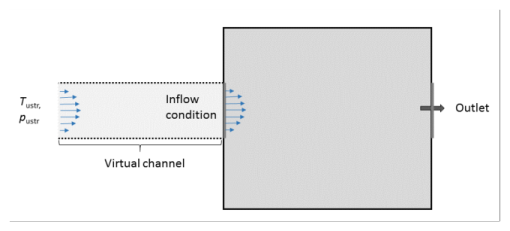The Inflow condition is available at boundaries that are exterior to a fluid domain and is equivalent to having a virtual channel “upstream”. It is used to define a heat flux at the inlet boundary that brings the same energy to the fluid domain as if you had modeled the virtual channel as a real CFD domain. The virtual channel can be seen as a long insulated channel with given thermal properties at the inlet, and with the same velocity profile as defined in the settings for the
Inflow boundary condition.

where the enthalpy variation ΔH depends on temperature and pressure difference:
Equation 3-1 expresses the fact that the normal conductive heat flux at the inflow boundary is proportional to the flow rate and enthalpy variation between the upstream conditions and inlet conditions.

